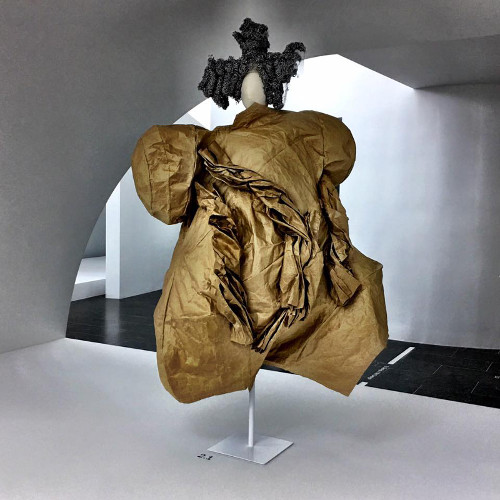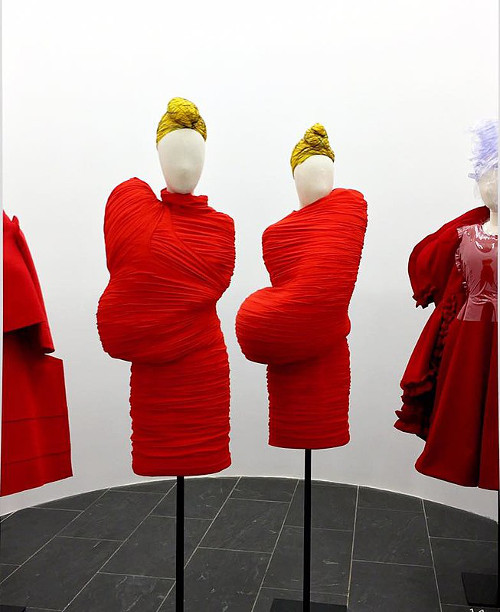Rei Kawakubo
Introduction
Rei Kawakubo made an entrance in the fashion scene in the 1980’s. The global fashion world that had thus far been dominated by mainly Western designers had to make room for a wave of Japanese designers, that brought with them new concepts of fashion. In May this year (2019) Rei Kawakubo received the Noguchi Award, an award first introduced in 2014 to ‘‘recognize innovative artists following in Isamu Noguchi’s (famous Japanese American artist and landscape architect) footsteps by bridging Eastern and Western cultures’’ (Vogue). After having accepted the award on the 2nd of May Rei Kawakubo stated: ‘‘I’m not an artist, and because of that I just wanted to say that it’s beyond my honor to receive this award, because I am not an artist. But I try, always, to come up with something new. Things that people have not seen, and I have gone this way for 50 years, and I’m very happy to be recognized for my achievement by receiving this award. Thank you.’’
Biography
Rei Kawakubo was born on 11 October 1942 in Tokyo. When she started university in 1960 she didn’t major in design but studied fine arts and literature at Keio university. After graduating and working in a textile company for two years she started designing her own clothes and established the label Comme des Garçons, French for "like some boys" in 1969. She opened her first boutique in 1975 and two years later she started presenting her designs in Paris Fashion Week. From that point onward she had made a name for herself as influential fashion designer and at 76 she is still the first one to arrive at her Tokyo studio.
 Figure 1
Figure 1
Wabi-sabi
Rei Kawakubo’s designs are highly influenced by the Zen-Buddhist concept of wabi-sabi. Wabi-sabi is an inherently Japanese concept and represents imperfection and incompletion, it derives from the Zen Buddhist concept of impermanence and constant flow. This is visible in Kawakubo’s asymmetric clothing pieces, misplaced garment details and ''unfinished'' looks. Concepts such as imperfection and incompletion are quick to have a rather derogative connotation in Western beauty ideals but designers such as Rei Kawakubo, Yohji Yamamoto and Issey Miyake popularized them.
 Figure 2
Figure 2
The concept of ma and deconstruction in Kawakubo's designs
Another characteristic of Rei Kawakubo’s designs is the deconstruction of clothing. The Western standard of constructing clothes is based on the human form, Western garments often follow the lines of the curves to fit the body. Kawakubo however pays more attention to the space between the garment and the body and doesn’t necessarily design clothes according to the shape of the body. The space between the body and cloth is called ma. This space, this nothingness is crucial in Kawakubo’s designs (Figure 2).
 Figure 3
Figure 3
Another way that Rei Kawakubo deconstructs clothing is through bumps and lumps on places that you wouldn’t expect. It is very common to use padding in clothing pieces but this is most often used to accentuate certain already existing body parts such as the shoulders or breasts. Rei Kawakubo however uses padding to create new body forms so that the body and the dress can become one, she explains it as ‘‘rethinking the body’’. An example of this is Rei Kawakubo’s red dresses from the exhibition Rei Kawakubo/Comme des Garçons – Art of the In-Between (Figure 3). Rei Kawakubo’s designs could be called anti-fashion in the sense that they didn’t agree with the dominating standard of fashion designs where garments were based on the human form. In her 2014 collection Not Making Clothes she abandoned the idea of clothes completely and designed highly abstract pieces that were completely independent from the body.
Sources
- Von Busch, Otto. ''Beyond the in-between: Rei Kawakubo at the Met and the clash between eastern and western concepts in fashion studies.'' International Journal of Fashion Studies, Volume 5 No.1 (2018): 111-128
- Lalloo-Morar, Sandhya. ''Design Innovation by Japanese Designers, Miyake, Kawakubo and Yamamoto.'' 2016
- Fury, Alexander. ''7 Key Themes in Rei Kawakubo’s Career.'' The New York Times Style Magazine, April 28, 2017. Accessed May 19, 2019.
- Yotka, Steff. ''A Chat With Rei Kawakubo as She Wins the Noguchi Award: “It’s Hard to Find Interesting, New Things”.'' Vogue, May 3, 2019. Accessed May 13, 2019.
- Nelson, Karin ''Fashion Icon Rei Kawakubo to Receive Isamu Noguchi Award: "I Am Not an Artist''.'' Architectural Digest, April 30, 2019. Accessed May 13, 2019.